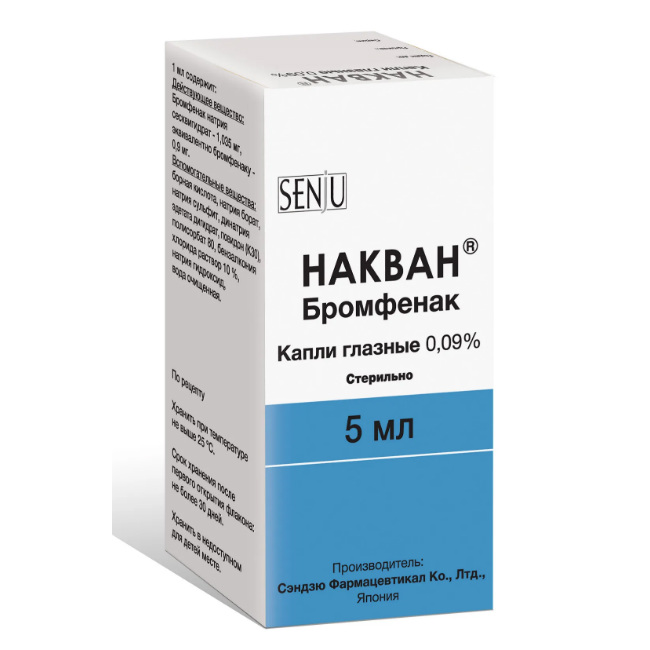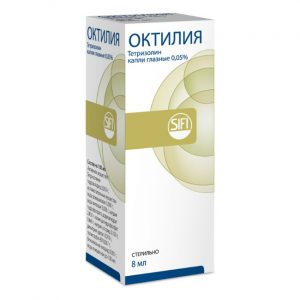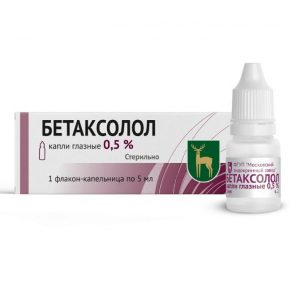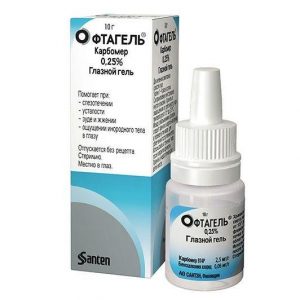Description
Pharmacological action
Bromfenac – a non-steroidal anti-inflammatory drug (NSAID), whose anti-inflammatory effect is realized by blocking the synthesis of prostaglandins when inhibiting cyclooxygenase 1 and 2.
In vitro studies, bromfenac inhibited prostaglandin synthesis in the rabbit ciliary body. The concentration of half-maximum inhibition (IC50) for bromfenac (1.1 Ñmol) was lower than for indomethacin (4.2 Ñmol) and pranoprofen (11.9 Ñmol).
In an experimental model of uveitis in rabbits, bromfenac at concentrations of 0.02%, 0.05%, 0.1% and 0.2% inhibited almost all symptoms of ocular inflammation.
Pharmacokinetics: Absorption
Bromfenac penetrates the cornea of ² ¹ ² ¹cataract patients efficiently: once administered, the average peak concentration in aqueous humor is 79 ± 68 ng / ml 150-180 minutes after application. This concentration persists for 12 hours in aqueous humor while maintaining measurable levels in the main tissues of the eye, including the retina, for up to 24 hours. When applying eye drops of bromfenac twice a day, concentlations in plasma were not quantifiable.
Distribution of
Bromfenac actively binds to plasma proteins. According to an in vitro study, protein binding in human plasma was 99.8%.
In vitro studies have not revealed biologically significant binding to melanin.
According to a study in rabbits using radioactively labeled bromphenac, the maximum concentration after topical administration is observed in the cornea, high in the conjunctiva and aqueous humor of the eye, and low in the lens and vitreous.
Metabolism
According to an in vitro study, the main metabolism of bromfenac is carried out by the enzyme CYP2C9, which is absent in the iridociliary zone, retina and choroid. The level of this enzyme in the cornea is less than 1% compared with the corresponding hepatic level.
When administered orally in humans, unmodified starting material is generally found in plasma. Several conjugated and unconjugated metabolites were isolated, the main of which is the cyclic amide, which is excreted in the urine.
Excretion of
When instilled into the eyes, the half-life of bromphenac from the aqueous humor of the eye is about 1.4 hours, which indicates rapid elimination.
After oral administration of 14C-bromfenac by healthy volunteers, it was found that the drug is mainly excreted in the urine (about 82% of the administered dose), while about 13% of the administered dose is excreted with feces.
Indications
Treatment of non-infectious inflammatory diseases of the anterior segment of the eye and postoperative inflammation.
Contraindications
This drug is contraindicated in patients who have a history of hypersensitivity to any component of the drug.
This drug is contraindicated in patients who have asthma attacks, urticaria and symptoms of acute rhinitis are worse when taking acetylsalicylic acid and other NSAIDs.
Age up to 18 years (safety and efficacy of the drug in children have not been investigated).
Use during pregnancy and lactation
There are no sufficient data on the use of bromfenac in pregnant women. Animal studies have demonstrated reproductive toxicity. The potential risk to humans is unknown. Since the systemic effect after treatment with the drug in non-pregnant women is negligible, the risk during pregnancy can be considered low.
However, due to the known effects of drugs that inhibit prostaglandin biosynthesis on the fetal cardiovascular system (duct closure), the use of this drug in the third trimester of pregnancy should be avoided. Generally, the use of this drug during pregnancy is not recommended, unless the benefit outweighs the potential risk.
Special instructions
This drug should be used as part of symptomatic treatment and not for the purpose of etiotropic therapy.
This medication should only be used as eye drops.
This drug should be instilled with care, making sure that the tip of the vial does not touch the surface of the eye.
This drug contains sodium sulfite, which can cause allergic reactions, including anaphylaxis and life-threatening or less severe asthmatic episodes in susceptible patients.
All topical NSAIDs can slow or delay healing like topical glucocorticosteroids. The combined use of NSAIDs and local steroids can increase the likelihood of healing problems.
Cross-sensitivity
There is a possibility of cross-sensitivity to acetylsalicylic acid, a phenylacetyl acid derivative and other NSAIDs. Therefore, caution should be exercised in treating individuals who have previously been sensitive to these drugs, and potential risks and benefits should be carefully evaluated.
Special patient groups
In susceptible patients, prolonged use of topical NSAIDs, including bromfenac, can lead to epithelial rupture, corneal thinning, corneal erosion, corneal ulceration, or corneal perforation. These events may threaten vision loss. Patients with signs of corneal epithelial destruction should immediately discontinue use of local NSAIDs and care should be taken to carefully monitor corneal health. Therefore, in patients at risk, the simultaneous use of ophthalmic corticosteroids with NSAIDs can lead to an increased risk of adverse events from the cornea.
Post-registration experience with
Post-registration experience with local NSAIDs indicates that patients with complications after ophthalmic surgery, corneal denervation, corneal epithelial defects, diabetes mellitus and superficial eye diseases, rheumatoid arthritis or repeated ophthalmic surgery during a short period of time, there may be an increased risk of adverse events from the cornea, which may become threatening loss of vision. Local NSAIDs in these patients should be used with caution.
reported that ophthalmic NSAIDs can cause increased bleeding in the tissues of the eye (including hyphema) in combination with ophthalmic surgery. Local NSAIDs should be used with caution in patients who have a history of bleeding, or if patients receive other medications that may increase blood clotting time.
Eye infections
The use of the drug should be carefully monitored and prescribed with caution in patients with inflammation caused by infections, as the drug may mask the symptoms of eye infections.
Using contact lenses
In general, wearing contact lenses during treatment with this drug is not recommended. In this regard, patients are not recommended to wear contact lenses, if you have not received clear instructions from your doctor.
Excipients
Since benzalkonium chloride is part of the drug, careful monitoring of patients is necessary in case of frequent or prolonged use of the drug. Benzalkonium chloride is known to discolour soft contact lenses. Contact with soft contact lenses should be avoided.
Benzalkonium chloride has been reported to cause eye irritation, acupuncture keratopathy and / or toxic ulcerative keratopathy.
Use in patients with hepatic and renal failure
The effect of the drug in patients with renal and hepatic insufficiency has not been studied.
Impact on the ability to drive transp. Wed and fur.: After instillation, transient blurred vision may be noted. In the case of blurred vision after instillation, it is necessary to refrain from driving a car or working with mechanisms until the clarity of vision is restored.
Composition
1 ml of the solution contains: Active ingredient: sodium bromfenac sesquihydrate – 1.035 mg, equivalent to bromfenac – 0.9 mg.
Excipients: boric acid – 11 mg, sodium borate – 11 mg, sodium sulfite – 2 mg, disodium edetate dihydrate – 0.2 mg, povidone (K30) – 20 mg, polysorbate 80 – 1.5 mg, benzalkonium chloride solution 10% – 0.1 μl, sodium hydroxide – up to pH 8, 0 – 8.6, purified water – up to 1 ml.
Dosage and administration
1-2 drops of the drug in the conjunctival sac twice a day for no more than 15 days.
If you miss a dose of the drug, the drug should be used as soon as possible in the dosage specified in the instructions for use. If the dose is skipped for about 24 hours, the drug should be used at the next scheduled time without doubling the dose to compensate for the missed dose.
Side effects of
Adverse reactions to the drug were observed in 72 of 3843 patients (1.87%), data about which were obtained in the framework of clinical trials or with post-registration use. Serious adverse reactions included corneal erosion in 16 cases (0.42%), conjunctivitis (including conjunctival injection and conjunctival follicles) in 11 cases (0.29%), blepharitis in 9 cases (0.23%), irritation in 8 cases (0.21%), eye pain [transient] in 8 cases (0.21%), superficial punctate keratitis in 6 cases (0.16%), pruritus in 6 cases (0.16%), corneal epithelium detachment in 1 case (0.03%) and a burning sensation [eyelids] in 1 case (0.03%).
Adverse reactions are classified according to the following gradation of frequency of occurrence:
Very often> 1/10
Often from? 1/100 to <1/10 Rarely from? 1/10000 to <1/100 Very rarely < 1/10000 In each group, adverse events are classified as their severity decreases and are grouped according to the frequency of occurrence and the organ-system class. The table below describes the adverse reactions. Occurrence frequency Adverse reaction Visual disturbances Infrequently Corneal erosion (*), conjunctivitis (*), blepharitis (*), irritation (*), eye pain [transient] (*), superficial point to *), itching (*) Rarely Detachment of corneal epithelium (*), burning sensation [eyelids] (*) Unknown Corneal ulcer (**) (***), corneal perforation (**) (*** ) Hypersensitivity Unknown Contact dermatitis (*) (*) If adverse reactions occur, discontinue treatment with the drug. (**) If clinically significant adverse reactions occur, such as the development of diseases of the corneal epithelium, etc., it is necessary to stop treatment with this drug and take appropriate measures. (***) Serious adverse reaction, isolated reports from the experience of post-registration use of the drug. Drug Interactions No other drug interaction studies have been conducted. Overdose There is currently no information on overdose when applied topically in humans. According to foreign reports, in patients who took the drug sodium bromfenac orally in a total dose exceeding 1500 mg for a long period of more than 1 month, serious liver dysfunction was observed (including fatal cases). In this regard, if abnormalities are found that are presumably associated with early symptoms of liver failure, it is necessary to stop treatment with this drug and take appropriate measures. Storage conditions Store at a temperature not exceeding 25 ° C. Keep out of the reach of children. Expiration 2 years. Do not use after the expiry date stated on the packaging. After opening the bottle for the first time, it should be stored for a maximum of 30 days. pharmacy terms for prescription Form of Treatment rims glazn e




